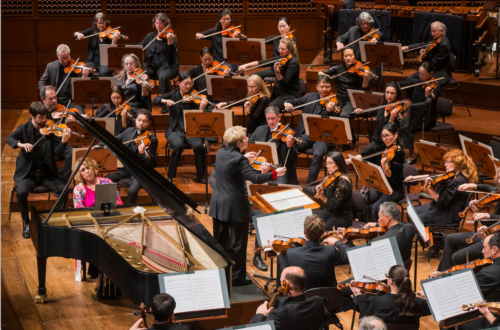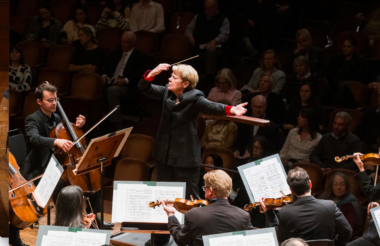 United States Various: Gabriela Montero (piano), San Francisco Symphony / Marin Alsop (conductor). Symphony Hall, San Francisco, 11.4.2025. (HS)
United States Various: Gabriela Montero (piano), San Francisco Symphony / Marin Alsop (conductor). Symphony Hall, San Francisco, 11.4.2025. (HS)

Gabriela Ortiz – Antrópolis
Gabriela Montero – Piano Concerto No.1, ‘Latin’
Copland – ‘Fanfare for the Common Man’
Joan Tower – ‘Fanfare No.1’ from Fanfares for the Uncommon Woman
Barber – Symphony No.1
Conductor Marin Alsop stormed into town like a bolt of energy for her long-awaited debut performance in a San Francisco Symphony subscription series. Alsop – chief conductor of the ORF Vienna Radio Symphony, artistic director and chief conductor of the Polish National Radio Symphony, principal guest conductor of London’s Philharmonia and the Philadelphia Orchestra – brought electricity to a program of music of the Americas, conducting with broad gestures and a palpable connection with the musicians of this orchestra.
The first half explored recent works bursting with Latin verve by composers of Mexican and Venezuelan heritage. After intermission, fanfares by Aaron Copland and Joan Tower preceded a superb performance of Samuel Barber’s Symphony No.1 – a specialty of Alsop’s.
In the second of three performances, the music brimmed with vitality. The opening salvo of timpani virtuosity in Gabriela Ortiz’s Antrópolis was delivered with panache by Edward Stephan, who engineered his array of kettledrums into a sort of conga-drum dream writ large. The title references the sounds of Mexico City’s cabaret and nightclub scene, a jumble of Latin rhythms, rumbas and similar musical gestures.
It was, in a word, a kick. With support from a lineup of cowbells, claves, maracas, guiro, egg shakers, woodblocks, tambourine, bongo drums, actual congas, tom-toms, rototoms, a brake drum and a tuneful marimba, the ten-minute piece bounced along with exuberance. It got a roaring response from the audience.
If anything, the concertgoers showed even more excitement for Gabriela Montero’s Piano Concerto No.1, with the composer at the piano. The Venezuelan pianist, educated at London’s Royal Academy of Music, has carved out a distinguished career as a soloist with an A-list of orchestras in Europe and the U.S. The concerto makes virtuosic technical demands on the soloist, but it does not interrupt the music’s flow with flights of solo cadenza. It is more of a shifting conversation between the soloist and the other musicians.
The piano starts things off with a high-lying wisp of a tune, given a whiff of dissonance from a second line not quite an octave below. It is the first intimation that this is going to be more than a cheerful ride on Latin colors. While Montero’s music keeps things going with jaunty rhythms, it darkens the colors with pungent harmonies from time to time. As she said in a brief introduction to the piece (made while the orchestra seating was being rearranged), this music reflects the ‘undercurrents of disruption’ from authoritarian governments that underlie the sunny image of many Latin American cultures, especially in Venezuela.
The orchestra picks up the tune, and the rest of movement – titled ‘Mambo’ – creates a sort of chiaroscuro of bright and dark music that adds depth to what could have been a simple romp. The slow movement starts off dreamily before a sinister march sneaks in and takes over (reminiscent of moments in the Shostakovich Symphony No.5), only to settle back into a dreamy finish.
The finale plays on ‘Pajarillo’, a Venezuelan song about a bird taken prisoner. The music seems carefree at first but doesn’t stay like that. The composer’s way of sneaking in the darkness made it feel organic, and in the end, the rhythms shook off the threats and ended with a flourish. Montero’s playing was crisp throughout, with Alsop managing a seamless integration with the orchestra’s detours.

You couldn’t ask for more extroverted, dynamic renditions of the two fanfares. Copland’s 1942 ‘Fanfare for the Common Man’ came first, a robust effort that stopped just short of blaring: muscular would be the word. Tower’s rebuttal from 1986, Fanfares for the Uncommon Woman (which was dedicated to Alsop) introduces more floral musical spins for the same instrumentation, and ‘Fanfare No.1’ made a fitting companion piece. (Footnote: Tower grew up in Bolivia, an extra layer of continuity with the South American angle to the program.)
Barber’s Symphony No.1, written in 1934 and revised in 1943, deserves a place on the Mount Rushmore of American symphonies from the first half of the twentieth century, alongside Copland’s No.3 and Ives’s ‘Holidays’ Symphony. In its brevity, with all four movements played without pause in twenty minutes, it bears a strong resemblance to the Sibelius No.7 but with distinctly freewheeling American aromatics.
Alsop has championed this Barber symphony, and she conducted it (and the ‘Fanfares’) without a score, drawing propulsive performances that didn’t miss any of the touchstones. Along the way, the three themes that construct the symphony’s first movement emerged with clarity as the composer developed them in the faster second movement and the harmonically rich Andante, climaxing with a frankly Sibelius-like run-up to the majestic close. The round-toned brass were especially critical to making it all work, as well as deftly played solos within the woodwinds.
Standing out among all that was a delicious bonbon of an encore after Montero’s concerto. Asking the audience to offer a tune for her to improvise on, she got a spectacular rendition of the Righteous Brothers’s ‘Unchained Melody’ from a professional-sounding audience member in the first tier. ‘That was beautiful’, she smiled, then picked out the tune on the piano and expanded it by applying pianistic virtuosity reminiscent of Mozart, Bach and Rachmaninoff.
You don’t hear something like that every day.
Harvey Steiman
